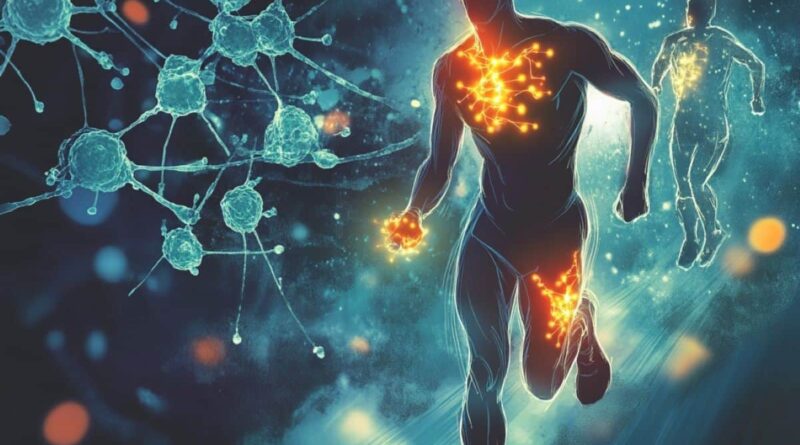A New Molecular Mechanism of Exercise and Fasting Effects – Neuroscience News
Summary: Researchers have created a molecule called LaKe that mimics the metabolic effects of intense exercise and fasting. This molecule increases lactate and ketone levels in the body, providing the same benefits as running 10 miles on an empty stomach, without physical exertion or dietary changes.
Currently being tested in human trials, LaKe shows promise in helping people with limited physical abilities maintain good health, and may even help treat brain conditions such as Parkinson’s and dementia . The discovery offers a possible new route for those who can’t follow rigorous exercise or dieting regimens.
Important information:
- The LaKe molecule mimics the effects of fasting and exercise by boosting lactate and ketones.
- Early research suggests it may help in conditions such as traumatic brain injury and dementia.
- Human trials are continuing to examine its use as a nutritional supplement for people who are unable to exercise.
Source: University of Aarhus
It is known that regular exercise and intermittent fasting have a series of positive effects on the body. Exercising and skipping meals make the heart stronger and reduce blood fat.
The explanation is based on the body’s natural reaction where the increase in lactate levels (lactic acid salt) and ketones act as efficient fuel for the cells that help the body’s organs.
A team of researchers in chemistry, metabolism and diabetes from Aarhus University has now created a molecule that can cause the same metabolic effects, without exercising or fasting.
The study was recently published in a scientific journal: Journal of Agricultural and Food Chemistry.
The same effect as a 10 km run on an empty stomach
“We have developed a molecule that can mimic the body’s natural response to vigorous exercise and fasting. In fact, the molecule brings the body to a metabolic state corresponding to running 10 kilometers at high speed on an empty stomach,” explains Professor Thomas Poulsen from the Department of Chemistry at Aarhus University. He is one of the lead researchers in this study.
“When blood lactate and ketone levels increase, appetite suppressing hormone production increases and free fatty acid levels in the blood decrease. This has many health benefits, for example, reducing the risk of metabolic syndrome. ”
According to the professor, it is impossible to achieve the same effect with food alone, since lactate and ketones, although they occur naturally, cannot be consumed in the necessary quantities without undesirable products such as acid and salt. This is where a new molecule, called LaKe, comes in.
Molecule > food ingredients
The development of LaKe is the result of several years of research collaboration between Thomas Poulsen, Professor Mogens Johannsen from the Department of Forensic Medicine, and chief physician and Professor Niels Møller, Department of Clinical Medicine and Steno Diabetes Center , Aarhus.
All three have researched metabolism from different angles, and all already knew from their own studies and those of others that lactate and ketones have beneficial effects. It took them three years to make a chemical mixture of lactate and ketones, without their dangerous ‘co-riders’ in the form of salts and acids.
In a way, we are not surprised by the result, because we are combining familiar things. The innovation is that we have now created a molecule that allows us to safely control the amount of lactate and ketones,” says Thomas Poulsen.
So far, the molecule has only been tested in rats, but the first clinical trials in humans are underway at Aarhus University Hospital.
According to Thomas Poulsen, the experiments are expected to pave the way for the molecule to become an advanced nutritional supplement. It will especially help people who cannot follow a strict exercise and diet plan.
It can be hard to have the motivation to run miles at a fast pace and not eat. “For people with physical ailments such as heart failure or general weakness, nutritional supplementation can be the key to a better recovery,” explains Thomas Poulsen.
Concepts in the treatment of traumatic brain injury
The molecule also has the potential to reduce concentration problems and could be used to treat serious diseases such as Parkinson’s and dementia. These diseases are often characterized by low energy levels in the brain, which prevent it from working properly.
“Because lactate can take over from glucose in the brain under stressful or stressful conditions, there have been attempts to increase lactate levels in people with concussions.
Thomas Poulsen explains: “Patients who cannot exercise vigorously will benefit greatly from a drug that can increase these conditions.
About this research issues neuropharmacology, diet and exercise
Author: Henriette Stevnhoej
Source: University of Aarhus
Contact: Henriette Stevnhoej – Aarhus University
Image: Image credited to Neuroscience News
Basic research: Open access.
“Preparation and Preclinical Behavior of a Simple Ester for the Optimal Supply of Lactate and Beta-hydroxybutyrate” by Thomas Poulsen et al. Journal of Agricultural and Food Chemistry
Summary
Preparation and Preclinical Behavior of a Simple Ester for the Combined Supply of Lactate and Beta-hydroxybutyrate
Increased plasma levels (S)-lactate (Lac) and/or (R)-beta-hydroxybutyrate (BHB) occurs naturally as a result of vigorous exercise and prolonged fasting, respectively, resulting in millimolar concentrations of these two metabolites.
It is increasingly recognized that Lac and BHB have many beneficial effects on the body, suggesting that nutritional solutions, consistent with high level and/or consistent use, allow to directly control the plasma levels of Lac and BHB, is of great interest.
In this study, we present a molecular hybrid between (S)-lactate and BHB-precursor (R)-1,3-butanediol in the form of a simple ester called LaKe.
We show that LaKe it can be easily prepared on a kilogram scale and rapidly hydrolytic under different physiological conditions to release its two components.
Eating with the mouth of LaKein rats, resulted in a dose-dependent increase in plasma levels of Lac and BHB to induce the expected physiological responses such as reduced lipolysis and increased appetite suppression. N-L-lactoyl-phenylalanine (Lac-Phe).
#Molecular #Mechanism #Exercise #Fasting #Effects #Neuroscience #News
